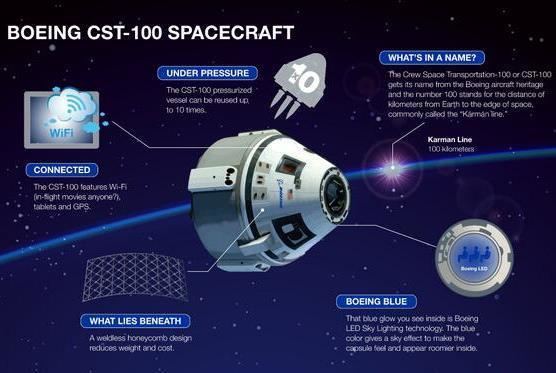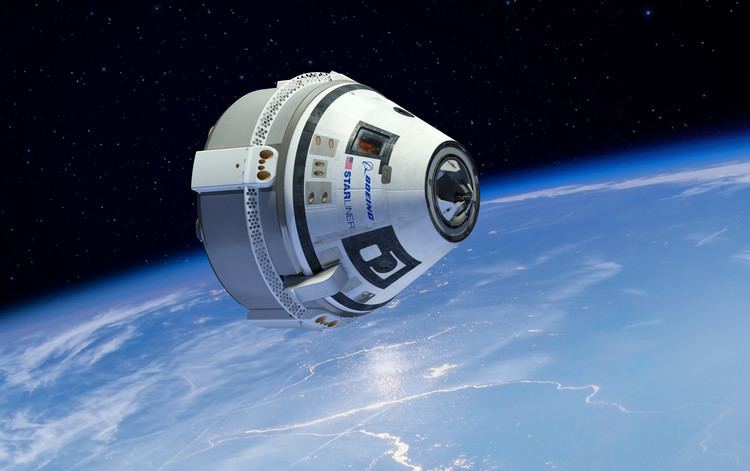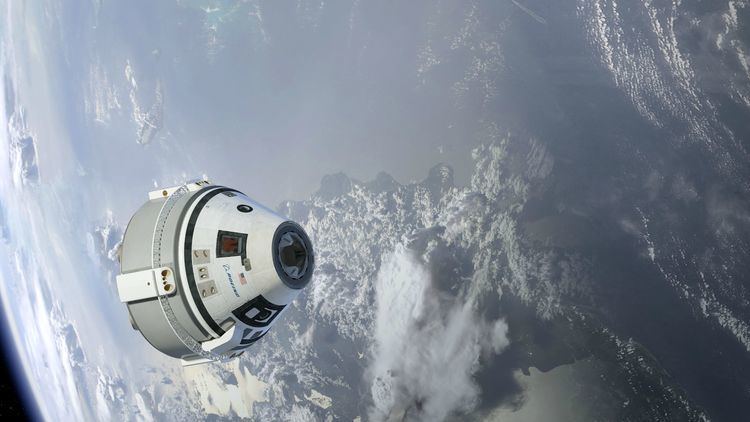Country of origin United States Regime Low Earth Cost 1.507 billion USD (2013) Operators Boeing, Bigelow Aerospace | Applications Crew Transfer Vehicle Status In development Manufacturers Boeing, Bigelow Aerospace | |
 | ||
Design life 60 hours (free flight)
210 days (docked) Dimensions Diameter (capsule max.): 4.56 m (15.0 ft)
Length (CM+SM): 5.03 m (16.5 ft) Similar Dragon V2, SpaceX Dragon, Orion, Cygnus, Soyuz | ||
Cst 100 starliner trainers astronauts fly boeing spacecraft
The CST-100 Starliner (Crew Space Transportation) crew capsule is a spacecraft design under construction by Boeing in collaboration with Bigelow Aerospace as their entry for NASA's Commercial Crew Development (CCDev) program. Its primary mission is to transport crew to the International Space Station and to private space stations such as the proposed Bigelow Aerospace Commercial Space Station.
Contents
- Cst 100 starliner trainers astronauts fly boeing spacecraft
- Boeing cst 100 starliner crew spacecraft mock up
- Background
- Development
- Testing
- Technology partners
- References

It is similar to the Orion, a spacecraft being built for NASA by Lockheed Martin. The capsule has a diameter of 4.56 meters (15.0 ft), which is slightly larger than the Apollo command module and smaller than the Orion capsule. The Starliner is to support larger crews of up to seven people and is designed to be able to remain on-orbit for up to seven months with reusability of up to ten missions. It is to be compatible with multiple launch vehicles, including the Atlas V, Delta IV, and Falcon 9, as well as the planned Vulcan. The initial launch vehicle would be the Atlas V, launched from SLC-41 at Cape Canaveral Air Force Station, Florida.

In the first phase of its CCDev program NASA awarded Boeing US$18 million for preliminary development of the spacecraft. In the second phase Boeing was awarded $93 million for further development. On August 3, 2012, NASA announced the award of $460 million to Boeing to continue work on the CST-100 under the Commercial Crew Integrated Capability (CCiCap) Program. On September 16, 2014, NASA selected the CST-100, along with SpaceX's Dragon V2, for the Commercial Crew Transportation Capability (CCtCap) program, with an award of $4.2 billion. The spacecraft is expected to fly unmanned in June 2018, have a first crewed test flight in August 2018, and ferry two astronauts to the ISS for the first fully operational flight in December 2018.

Boeing cst 100 starliner crew spacecraft mock up
Background
The design draws upon Boeing's experience with NASA's Apollo, Space Shuttle and ISS programs as well as the Orbital Express project sponsored by the Department of Defense. The CST-100 has no Orion heritage, but it is sometimes confused with the earlier and similar Orion-derived Orion Lite proposal that Bigelow was reportedly working on with technical assistance from Lockheed Martin. It will use the NASA Docking System for docking and use the Boeing Lightweight Ablator (BLA) for its heatshield.
As of 2014, the CST-100 was to include one space tourist seat, and the Boeing contract with NASA allows Boeing to price and sell passage to low-Earth orbit on that seat.
Development
The CST-100 name was first used when the capsule was revealed to the public by Bigelow Aerospace CEO Robert Bigelow in June 2010. The letters CST stand for Crew Space Transportation. Although it has been reported that the number 100 in the name stands for 100 km, the height of the Kármán line which is one of several definitions of the boundary of space. the naming was in fact an arbitrary designation created by the corporate office. The Rocketdyne RS-88 (Bantam) engine will be used for its launch escape system.
Receiving the full fixed-price payments for the CCDev Phase 1 Space Act Agreement required a set of specific milestones to be met during 2010:
As of July 2010, Boeing stated that the capsule could be operational in 2015 with sufficient near-term approvals and funding, but also indicated they would proceed with development of the CST-100 only if NASA implemented the commercial crew transport initiative that was announced by the Obama administration in its FY11 budget request. Boeing executive Roger Krone stated that NASA investment would allow Boeing to close the business case, while this would be very difficult without NASA. In addition a second destination besides the ISS would be needed to close the business case and Krone said that cooperation with Bigelow was crucial for this.
Boeing was awarded a $92.3 million contract by NASA in April 2011 to continue to develop the CST-100 under CCDev phase 2. On August 3, 2012, NASA announced the award of $460 million to Boeing to continue work on the CST-100 under the Commercial Crew Integrated Capability (CCiCap) Program.
On October 31, 2011, NASA announced that through a partnership with Space Florida, the Orbiter Processing Facility-3 at Kennedy Space Center would be leased to Boeing for manufacture and test of CST-100 spacecraft.
On September 16, 2014, NASA chose Boeing (CST-100) and SpaceX (Dragon V2) as the two companies that will be funded to develop systems to transport U.S. government crews to and from the International Space Station. Boeing won a $4.2 billion contract to complete and certify CST-100 spacecraft by 2017, while SpaceX won a $2.6 billion contract to complete and certify their crewed Dragon spacecraft. The contracts include at least one crewed flight test with at least one NASA astronaut aboard. Once the Starliner achieves NASA certification, the contract requires Boeing to conduct at least two, and as many as six, crewed missions to the space station. NASA's William H. Gerstenmaier considers the CST-100 proposal as stronger than the two others.
Part of the agreement with NASA allows Boeing to sell seats for space tourists. Boeing proposed including one seat per flight for a space flight participant at a price that would be competitive with what Roscosmos charges tourists.
On September 4, 2015, Boeing announced that the CST-100 would officially be called the CST-100 Starliner, a name that follows the conventions of the 787 Dreamliner produced by Boeing Commercial Airplanes. In November 2015, NASA announced it had dropped Boeing from consideration in the multibillion-dollar Commercial Resupply Services second-phase competition to fly cargo to the International Space Station.
In May 2016, Boeing delayed their scheduled first launch of a CST-100 from 2017 into early 2018.
In October 2016, Boeing delayed its commercial crew development and test program by six months, from early 2018 to late 2018, following supplier holdups and a production problem on the second CST-100. They are hoping to fly NASA astronauts to the ISS by December 2018.
Testing
A variety of validation tests are underway on the test article.
In September 2011, Boeing announced the completion of a set of ground drop tests to validate the design of the air bag cushioning system. The air bags are located underneath the heat shield of the CST-100, which is designed to be separated from the capsule while under parachute descent at about 5,000 feet (1,500 m) altitude. The air bags are deployed by filling with a mixture of compressed Nitrogen and Oxygen gas, not with the pyro-explosive mixture sometimes used in automotive air bags. The tests were carried out in the Mojave Desert of southeast California, at ground speeds between 10 and 30 miles per hour (16 and 48 km/h) in order to simulate cross wind conditions at the time of landing. Bigelow Aerospace built the mobile test rig and conducted the tests.
In April 2012, Boeing dropped a mock-up of its CST-100 commercial crew capsule over the Nevada desert at the Delamar Dry Lake near Alamo, Nevada, successfully testing the craft's three main landing parachutes from 11,000 feet (3,400 m).
On August 19, 2013 (National Aviation Day), Boeing announced that two NASA astronauts evaluated communications, ergonomics and crew-interface aspects of the CST-100, showing how future astronauts will operate in the spacecraft as it transports them to the International Space Station and other low Earth orbit destinations.
Boeing reported in May 2016 that their test schedule would slip by eight months due to the need to reduce the mass of the spacecraft and aerodynamics issues anticipated during launch and ascent with the Atlas V carrier rocket. The pad abort test is now scheduled for October 2017, and the uncrewed test mission to the ISS (Boe-OFT) for June 2018. The first crewed flight (Boe-CFT) is now scheduled for August 2018 and will last 14 days - carrying one NASA astronaut and one Boeing test pilot to the ISS. NASA has named its first Commercial Crew astronaut cadre of four veteran astronauts to work with Space X and Boeing: Robert Behnken, Eric Boe, Sunita Williams, and Douglas Hurley.
